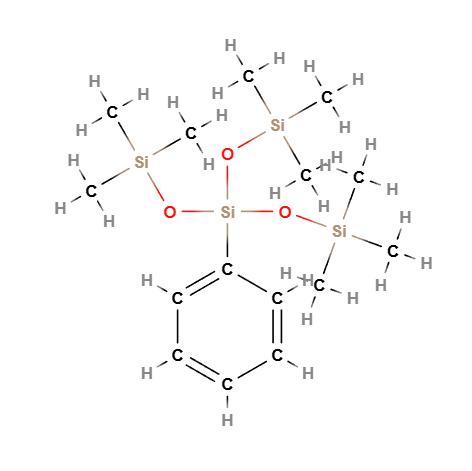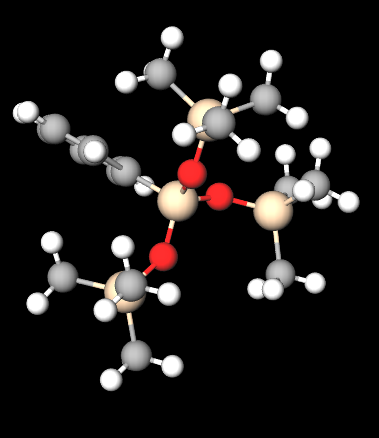Check the ingredients!
... live healthy!


| "Descrizione" by admin (19362 pt) | 2024-Oct-08 11:18 |
Phenyl Trimethicone is a volatile silicone commonly used in cosmetic products for its emollient, smoothing, and film-forming properties. This ingredient helps improve the texture of products and provides a silky feel to the skin and hair. Due to its ability to form a lightweight protective barrier, it is often used in haircare, skincare, and makeup formulations to enhance shine and improve the final appearance.
Chemical Composition and Structure
Phenyl Trimethicone is a silicone modified with a phenyl group, which makes it less volatile compared to other silicones. Its chemical structure allows it to form a film on the skin and hair, creating a smooth and glossy surface without weighing it down. The phenyl group also enhances its light-dispersing properties, increasing shine.
Physical Properties
It generally appears as a clear, colorless liquid with a light, non-greasy consistency. It is insoluble in water but miscible with oils and other silicones. Phenyl Trimethicone is prized for its ability to improve the texture of cosmetic products, providing a silky and dry-touch feel.
Production Process
Phenyl Trimethicone is produced through a chemical synthesis process where a phenyl group is bonded to a silicone chain. This process gives the ingredient its unique properties, such as forming a lightweight, durable film, making it ideal for high-performance cosmetic products.
Applications
Haircare: Used in shampoos, conditioners, serums, and styling products to enhance shine, reduce frizz, and make hair softer and silkier.
Skincare: Employed in creams and lotions to provide a smoothing, silky effect while creating a lightweight protective barrier on the skin without clogging pores.
Makeup: Used in foundations, primers, and makeup products to improve application, provide a smooth finish, and increase product longevity.
INCI Functions:
Antifoaming agent. The constituent factors for foam stabilisation are the concentration of nanoparticles and hydrophobicity. Foam, even when used in separation operations such as fractionation or flotation, can cause a decrease in density and a deterioration in quality in cosmetic products. The defoaming agent (non-polar oil, silicone oils, hydrophobic solid particles or mixtures of both) is strongly influenced by viscosity and, to an almost directly proportional extent, concentration. However, defoamers can carry an irreversible source of contamination.
Hair conditioning agent. A large number of ingredients with specific purposes can co-exist in a hair shampoo: cleansers, conditioners, thickeners, mattifying agents, sequestering agents, fragrances, preservatives, special additives. However, the indispensable ingredients are the cleansers and conditioners as they are necessary and sufficient for hair cleansing and manageability. The others act as commercial and non-essential auxiliaries such as: appearance, fragrance, colouring, etc. Hair conditioning agents have the task of increasing shine, manageability and volume, and reducing static electricity, especially after treatments such as colouring, ironing, waving, drying and brushing. They are, in practice, dispersing agents that may contain cationic surfactants, thickeners, emollients, polymers. The typology of hair conditioners includes: intensive conditioners, instant conditioners, thickening conditioners, drying conditioners.
Skin conditioning agent. It is the mainstay of topical skin treatment by restoring, increasing or improving skin tolerance to external factors, including melanocyte tolerance. The most important function of the conditioning agent is to prevent skin dehydration, but the subject is rather complex and involves emollients and humectants.
Skin conditioning agent - Emollient. Emollients have the characteristic of enhancing the skin barrier through a source of exogenous lipids that adhere to the skin, improving barrier properties by filling gaps in intercorneocyte clusters to improve hydration while protecting against inflammation. In practice, they have the ability to create a barrier that prevents transepidermal water loss. Emollients are described as degreasing or refreshing additives that improve the lipid content of the upper layers of the skin by preventing degreasing and drying of the skin. The problem with emollients is that many have a strong lipophilic character and are identified as occlusive ingredients; they are oily and fatty materials that remain on the skin surface and reduce transepidermal water loss. In cosmetics, emollients and moisturisers are often considered synonymous with humectants and occlusives.
CAS: 2116-84-9
EC number 218-320-6
Health and Safety Considerations
Safety in Use
Phenyl Trimethicone is considered safe for use in cosmetic products. It is generally well-tolerated by the skin and hair, and it is not known to cause irritation or sensitization. However, as with any cosmetic ingredient, a patch test is recommended for individuals with sensitive skin.
Allergic Reactions
Allergic reactions to Phenyl Trimethicone are rare. Due to its inert chemical structure, it is considered safe for use on all skin types, including sensitive skin.
Toxicity and Carcinogenicity
There is no evidence that Phenyl Trimethicone is toxic or carcinogenic. It has been extensively tested for use in cosmetics and poses no known health risks when used in recommended concentrations.
Environmental and Safety Considerations
Like other silicones, Phenyl Trimethicone is not biodegradable and can accumulate in the environment. While it is not considered toxic to the environment, proper disposal of products containing silicones is important to minimize environmental impact.
Regulatory Status
Phenyl Trimethicone is approved for use in cosmetics in many regions, including the European Union and the United States, where it is regulated to ensure safe use.
 |  |
Molecular Formula C15H32O3Si4
Molecular Weight 372.75 g/mol
CAS 2116-84-9
UNII S3QI0ZXT5X
EC Number 218-320-6
DTXSID6051857
Nikkaji J298.707D
Synonyms:
Phenyltris(trimethylsiloxy)silane
References__________________________________________________________________________
Williams RL, Kearns VR, Lo AC, Day M, Garvey MJ, Krishna Y, Ma D, Stappler T, Wong D. Novel heavy tamponade for vitreoretinal surgery. Invest Ophthalmol Vis Sci. 2013 Nov 5;54(12):7284-92. doi: 10.1167/iovs.13-11876.
Abstract. Purpose: The aim of this study was to produce a heavy tamponade with a specific gravity greater than 1.06 g/mL that was optically transparent, could be manufactured using simple processing, could be injected using standard clinical equipment, and would have appropriate biocompatibility. Methods: Aerosil silica was added to a phenyl trimethicone and mixed via a roller, overhead stirring, and ultrasonics. The refractive index, visible absorbance, and shear viscosity were measured. The injectability of the solutions was evaluated using the Accurus Viscous Fluid Injection system. The tamponade efficiency was assessed using a model eye chamber and compared with that of Densiron 68, Oxane HD, and F6H8. The biocompatibility was evaluated in vitro and in vivo in rabbits.....Conclusions: We have produced a heavy tamponade with good clarity that has appropriate shear viscosity, injectibility, enhanced tamponade efficiency, and biocompatibility similar to that of PDMS 1000.
Shank, R. C., Slaga, T. J., Snyder, P. W., & Tilton, S. C. Safety Assessment of Phenyl-Substituted Methicones as Used in Cosmetics.
In 1986, the Expert Panel for Cosmetic Ingredient Safety (Panel) published a final report on the safety of Phenyl Trimethicone, with the conclusion that Phenyl Trimethicone is safe as a cosmetic ingredient in the practices of use and concentration described in the safety assessment.3 The Panel reaffirmed this conclusion in 2006.
| Evaluate |